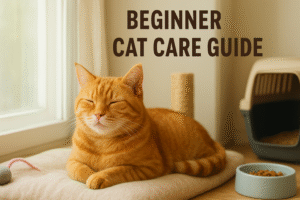What Does Cat Care Involve?
Caring for a cat goes beyond food and cuddles. Cats are independent, but they rely on you for safety, health, and enrichment. A complete cat care routine includes:
-
Nutritious feeding and fresh water
-
Regular veterinary checkups and preventive care
-
Grooming and hygiene
-
Litter training and cleanliness
-
Mental and physical stimulation
-
Safe, cat-friendly living space

Indoor vs. Outdoor Cat Care: Key Differences
-
Indoor cats usually live longer and healthier lives. They’re less exposed to diseases, cars, and predators.
-
Outdoor cats get more stimulation but face higher risks. If you choose outdoor access, consider cat-proof fencing or leash training.
Cat Care vs. Dog Care
Unlike dogs, cats thrive on independence. They need vertical space (cat trees, shelves), quiet resting spots, and routine more than constant interaction.
Preparing for Your First Cat
Essential Supplies Every Cat Owner Needs
-
Litter box + litter scoop
-
Food and water bowls (stainless steel recommended)
-
Quality cat food (age-appropriate)
-
Scratching post or cat tree
-
Comfortable bed
-
Carrier for vet visits
-
Interactive toys (wand toys, puzzle feeders)
Creating a Safe and Cat-Friendly Home
-
Remove toxic plants like lilies or poinsettias.
-
Keep cords, string, and rubber bands out of reach.
-
Provide safe hideouts (cat caves or cozy blankets).
Choosing the Right Veterinarian
Pick a vet experienced in feline medicine. Schedule an initial wellness exam within the first week of adoption.
Pet Health Basics: Common Signs, Symptoms, and Care.
Feeding and Nutrition Basics
Wet Food vs. Dry Food: Pros and Cons
-
Wet food: Adds hydration, usually more palatable.
-
Dry food: Convenient, longer-lasting, helps with dental health.
-
Many vets recommend a balanced mix of both.
How Much Should You Feed Your Cat Daily?
Most adult cats need 200–250 calories per day (check packaging + vet advice). Portion control helps prevent obesity.
Safe & Unsafe Foods for Cats
-
Safe: Small amounts of cooked chicken, pumpkin, carrots.
-
Unsafe: Onions, garlic, chocolate, grapes, alcohol, dairy.
Safe and Unsafe Foods for Dogs and Cats.
Special Diets for Kittens, Adults, and Seniors
-
Kittens: High-protein kitten food until ~12 months.
-
Adults: Balanced diet for weight maintenance.
-
Seniors: Low-calorie, joint-support supplements.
Litter Training and Bathroom Habits
How to Litter Train a Kitten Quickly
-
Choose a quiet, accessible spot.
-
Place kitten in the litter box after meals and naps.
-
Reward success with praise or treats.
Best Types of Litter and Boxes for Beginners
-
Clumping litter: Easy cleaning.
-
Non-clumping: Good for kittens.
-
Covered boxes: Reduce odor but some cats dislike them.
Solving Common Litter Box Problems
-
Odor: Clean daily, replace litter weekly.
-
Refusal: Try a different litter texture.
-
Accidents: Rule out health issues like UTIs.
Grooming and Hygiene Care
Brushing Tips for Short-Haired vs. Long-Haired Breeds
-
Short-haired cats: Weekly brushing.
-
Long-haired cats: Daily brushing to prevent mats.
Cat Grooming Tips for Long-Haired Breeds.
Bathing Cats: When Is It Necessary?
Most cats groom themselves well. Bathe only if they’re very dirty or have skin conditions.
Nail Trimming Tips for Beginners
-
Use a cat-specific clipper.
-
Trim just the sharp tip, avoiding the pink quick.
Cat Nail Trimming Tips for Beginners.
Preventing Hairballs and Shedding
-
Regular brushing
-
Specialized anti-hairball cat food
-
Add fiber (pumpkin) if vet-approved
Health and Wellness Essentials
Vaccinations and Preventive Care
Core vaccines: Rabies, feline distemper, and feline herpesvirus.
Signs of Common Cat Health Problems
-
Stress: Hiding, overgrooming
-
Fleas: Scratching, black specks in fur
-
Dental issues: Bad breath, drooling
When to Take Your Cat to the Vet
-
Sudden weight loss
-
Difficulty breathing
-
Refusal to eat for 24+ hours
-
Lethargy or hiding behavior
Indoor Enrichment for Mental Health
-
Puzzle feeders
-
Window perches
-
Catnip toys
-
Climbing trees
Understanding Cat Behavior
Why Cats Knead, Scratch, and Meow
-
Kneading: Comfort, kitten instincts.
-
Scratching: Territory marking + claw health.
-
Meowing: Communication with humans.
How to Stop Cats from Scratching Furniture
-
Offer scratching posts near problem areas.
-
Use double-sided tape or furniture protectors.
Socializing Cats with People and Pets
Introduce slowly with scent swapping. Reward calm interactions.
Building Trust and Bonding with Your Cat
Respect boundaries, use playtime, and reward affection.
Must-Have Products for New Cat Owners
Best Litter Boxes, Scratching Posts, and Cat Trees
Invest in sturdy, tall cat trees and odor-control litter systems.
Interactive Toys for Indoor Cats
Wand toys, laser pointers, and puzzle feeders.
Best Interactive Toys for Indoor Cats.
Cat Carriers, Beds, and Grooming Tools
Choose a sturdy carrier with good ventilation and cozy bedding.
Common Mistakes New Cat Owners Make (and How to Avoid Them)
-
Overfeeding and causing obesity
-
Ignoring litter box preferences
-
Skipping preventive vet care
-
Not providing scratching outlets or playtime
Expert Tips for First-Time Cat Owners
-
Stick to routines (feeding, play, rest).
-
Use positive reinforcement, not punishment.
-
Respect your cat’s need for independence.
FAQs About Cat Care for Beginners
Q1: How often should you take your cat to the vet?
At least once a year for wellness exams; kittens and seniors may need more visits.
Q2: Do indoor cats need vaccines?
Yes—core vaccines protect against viruses even indoor cats can be exposed to.
Q3: Can cats be left alone for a weekend?
With enough food, water, and litter boxes, most cats can. Longer absences require a pet sitter.
Q4: How long does it take for a cat to adjust to a new home?
Most cats take 1–2 weeks, though some may need longer.
Q5: How do I know if my cat is happy?
Purring, slow blinking, kneading, playful behavior, and relaxed posture are good signs.
Conclusion
Bringing a cat into your life is rewarding, but it requires preparation and commitment. From feeding and litter training to grooming and vet care, this cat care starter guide covers the essentials every beginner should know.
👉 Ready to learn more? Explore our Cat Care Guides and give your feline friend the best start possible.
